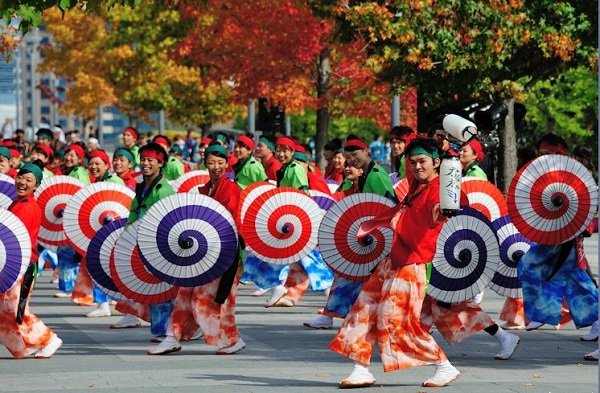Yosakoi - Traditional Japanese dance
(BNP) - The symbol of Japan is the image of cherry blossoms, Mount Fuji, kimonos, or typical sushi dishes. In recent years, the Yosakoi dance has become a traditional dance of Japanese people. Japanese people have become familiar with Vietnamese people in general, especially Vietnamese students in particular.

Yosakoi is a Japanese dance style which combines elements of traditional Japanese dance and music with a variety of modern influences, and is performed at a number of festivals throughout Japan.
Yosakoi incorporates traditional Japanese folk music (Min’yō), and dance (such as Nihon Buyō and Bon Odori) as well as jazz, rock, hip hop, samba and many other music and dance styles. If you have never seen Yosakoi before, you can expect an energetic dance with a traditional Japanese influence.
In 1954, the Shikoku city of Kochi, concerned to boost local morale on the heels of the long struggle of post-war recovery, hit on an idea for a new kind of festival dance. The dance would be based on Japan’s festival dance tradition, but would allow for modern variations, even modern music and different kinds of costumes. They called their dance Yosakoi.
Yosakoi dancing has spread throughout much of Japan since 2005 with hundreds of festivals and competitions. Yosakoi is not only famous in Japan but also in many countries around the world. Yosakoi has become so popular that over 200 areas in Japan now have their respective teams
The style of dance is highly energetic, combining traditional Japanese dance movements with modern music. The choreographed dances are often performed by large teams. Along with a number of professional yosakoi schools and town dance teams, yosakoi is also a popular event during the sports festivals held by Japanese elementary, junior, and senior high schools. Its participants include men and women of almost all ages – sometimes within a single team.
The costumes used by yosakoi teams vary widely. Happi coats and yukata are the most predominant costumes and can be seen in a wide variety of colors. However, some groups choose costumes that are based on historical attire, popular fashions, or ethnic fashions. Typically, all members of a team wear similar costumes.
One of the defining aspects of yosakoi dance is the use of naruko: small wooden clappers that are held in the hands of each dancer. Naruko were originally used in Kōchi Prefecture to scare birds away from rice fields. The traditional naruko has black and yellow beaters on a wooden body, but most modern yosakoi groups create their own naruko, choosing colors and materials that match their costumes. The use of naruko is required in traditional yosakoi dance, but many groups also use other hand-held instruments or props, such as drums, other percussion instruments, flags, batons, and floats.
The official yosakoi dance is based on a song called "Yosakoi Naruko Dancing", written by Eisaku Takemasa. This song was created by combining elements of three songs: "Yosakoi-bushi" ("yosakoi melody"), "Yocchore" (a children's song), and "Jinma-mo" (a folk song of Kōchi Prefecture). The original competition in Kōchi requires that each team's music include some part of this original music. Competitions and festivals in other areas may not have this requirement (thus allowing teams to compose their own music), or may require that elements of different local folk songs are worked into the dance routines. Takemasa has given the copyright on "Yosakoi Naruko Dancing" to the public.
Not only in Yosakoi's hometown, but all over the world, Yosakoi fans also established their own clubs and groups. In Penang city, Malaysia hosts an annual celebration in March. Other nations, such as the United States, the Netherlands, France, and Sweden have numerous Yosakoi groups with popular activities, attracting a large number of young people, particularly those interested in Japanese culture.
Vietnam is also one of the countries that has a love for Yosakoi and Japanese culture. After more than 10 years of organizing cultural festivals, many Yosakoi teams have also been born and grown stronger. Many teams also had the opportunity to go to Japan to perform and win prizes in Yosakoi competitions.






